
© Kiyonori Hasegawa. (Click image for larger version)
Australian Ballet
Manon
Sydney, Sydney Opera House
19 April 2014
www.australianballet.com.au
www.sydneyoperahouse.com
Kenneth MacMillan’s Manon has always been a star attraction in the repertoire of the Australian Ballet since its company premiere in 1994, and the Australian Ballet’s 2014 season has included performances of it in Brisbane, Melbourne and Sydney. However, the one performance I had seen of the 2014 staging left me underwhelmed. The story seemed to live more in the printed program than onstage, despite some valiant work by one or two principals, and there seemed to be a lot of standing around on the edges of the stage watching others but not being involved in the action at all. Enter Alina Cojocaru and Johan Kobborg for guest appearances (just two of them) in Sydney.
After twenty years of watching Manon, including that one unsatisfying show this year, it was a real thrill to sit in the Joan Sutherland Theatre at the Sydney Opera House and see MacMillan’s choreography revealed by Cojocaru and Kobborg. And revealed it was in all its intricacy and beauty and in its inherent capacity to carry a storyline through movement. Cojocaru and Kobborg work so intelligently together. Every move appears to be considered. Every step is made meaningful. Every interaction between them has a purpose.

© Jim McFarlane. (Click image for larger version)
Kobborg is not the technician he once was I have to say. His limbs no longer stretch and extend to the same extent as they once did; the jumps are not as high; the bends not as deep; and the balances not as steady. But his every movement is, nevertheless, highly articulate. The choreography looks like more than just a series of spectacular steps, there is light and shade in what he does, and his characterisation is masterful. As the young student, des Grieux, arriving in Act I with his books under his arm, looking slightly bewildered and lost in his studies, he is disarmingly attractive. As a lover he is ardent and his emotions overflow. As a rejected lover in Act II he is again bewildered, and his searching looks from across the stage to Manon are moving in their simplicity as he watches her engage with the wealthy Monsieur GM. He never stops trying to understand why he is in such a situation and one’s eyes keep returning to him rather than focusing on the harlots displaying their legs for the benefit of Madame X’s patrons. And his partnering of Cojocaru has lost none of its touch as he engages her in MacMillan’s excitingly acrobatic but beautifully flowing movements. Their various pas de deux were pretty much flawless, I thought, and his Act I solo, performed in a small circle and brimming with curves, arcs and other fluent circular movements, was a real eye-opener in terms of showing MacMillan’s choreographic approach.

© Kiyonori Hasegawa. (Click image for larger version)
Cojocaru herself continues to move with the lightness and delicacy that I recall, still quite clearly, from her performances in Australia as Giselle when the Royal Ballet toured here in 2002. But she never uses her formidable technique in a showy manner. There is always a reason behind an arabesque, a tiny stabbing movement of the foot on the ground, or a swirl of movement around her partner’s body. She too works to develop a persona for the character she is playing. Her Manon is all sweetness and light, playful and charming. Her change of heart as she goes to Monsieur GM is, therefore, made all the more noticeable. And, occasionally when with Monsieur GM, she gives a little clue, a hurried glance at des Grieux, that make us wonder what is really inside her heart.
The dancing of Kobborg and Cojocaru was beautifully supported by Steven Heathcote as Monsieur GM and Andrew Killian as Lescaut, brother of Manon. Killian was probably the most technically accomplished male dancer on stage and his Act I solo was especially exuberant. Heathcote, former Australian Ballet principal artist, brought his extensive performing experience to his role. He was quite brutal in his portrayal of Monsieur GM, full of barely concealed lust and a kind of imperious haughtiness as he tossed his money around whenever he fancied. The pas de trois between Manon, Lescaut and Monsieur GM in Act I, Scene 2, as Lescaut gives Monsieur GM access to his sister, was particularly strong with its slow and sexually suggestive choreography precisely executed by all three dancers. Heathcote’s interaction with Manon and Madame X at the card table, downstage prompt corner, during Act II also had a certain hypnotic power. His performance at that point was unhurried and considered with a slight overtone of superiority, so watching him slowly become drunk and eventually filled with anger was quite startling and done, thankfully, without even a hint of overplaying the drunkenness. It is a treat, although it should always be the case, to have action going on at the side that is telling its own story.
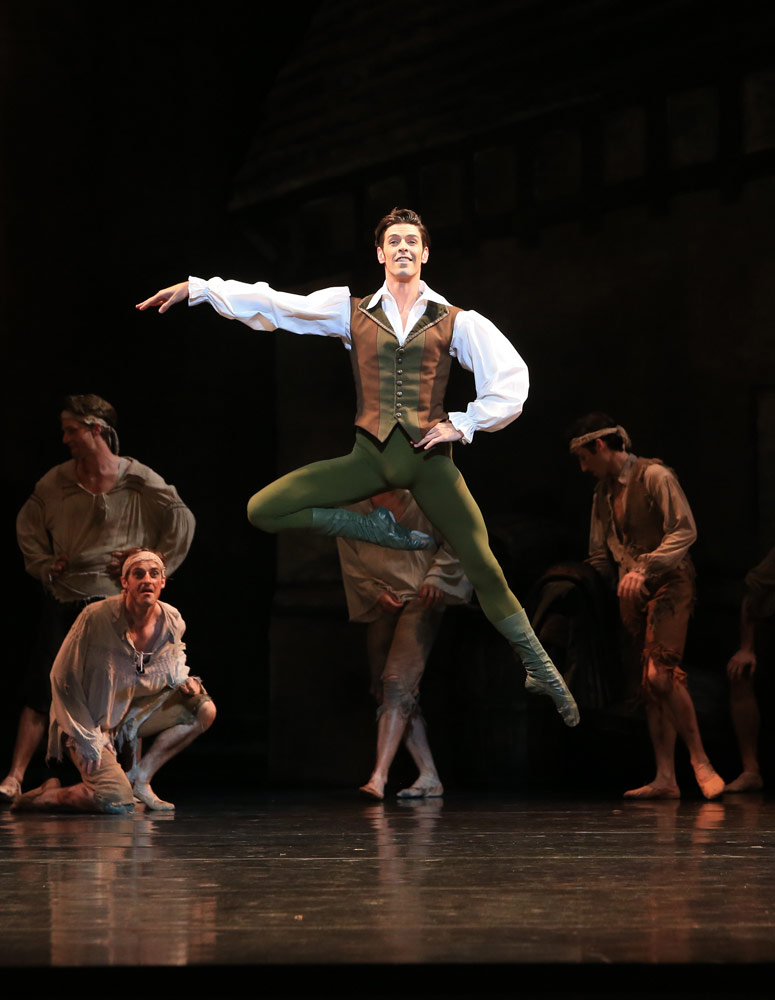
© Jim McFarlane. (Click image for larger version)
I can’t ever imagine being a fan of Act III of Manon. Those mud-smeared, nastily bewigged ‘convicts from France’ have probably the least interesting choreography in the whole ballet and I have yet to see a convincing performance from those characters, or one that is imbued with any sense of the theatrical rather than the boring or the melodramatic. However, Cojocaru and Kobborg managed, to their credit, to make the death scene in the swamps more bearable than usual by making the links back to earlier scenes more obvious and more potent. For once it didn’t seem like an interminable ‘I’m dying’ dance.
The presence of Cojocaru and Kobborg in Manon, apart from giving such pleasure in itself, lifted the Australian Ballet’s production and took it to a different level. And bouquets to Steven Heathcote for a remarkable performance as well.








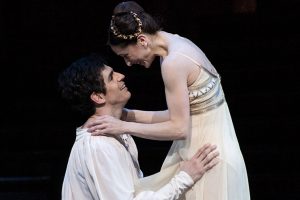
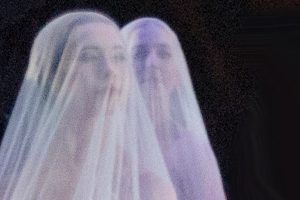
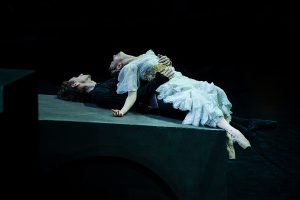
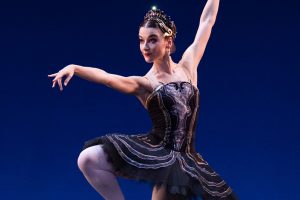
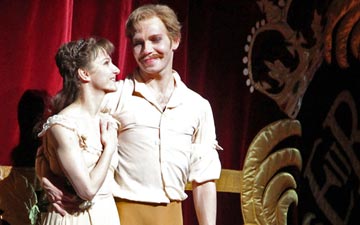
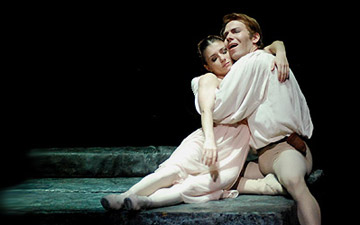
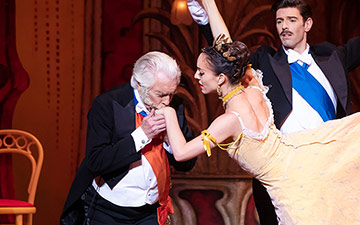
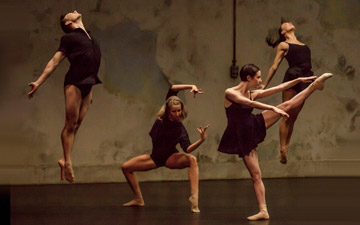
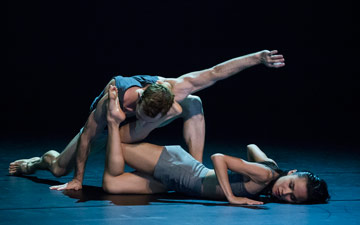
[…] The second show I saw, however, made up for it all. My thoughts on this performance, which featured guest artists Alina Cojocaru and Johan Kobborg as Manon and des Grieux respectively, appear on DanceTabs at this link. […]
It was an unalloyed treat to read Michelle Potter’s review. Kobborg appeared at
San Francisco Ballet’s Gala and Cojocaru as guest artist in Hamberg Ballet’s
Midsummer’s Nights Dream, so I have enjoyed a glimpse of them separately as
well as together in a 2000 Gala in Seoul, South Korea. Potter gives them full,
considered justice. Dance tabs is lucky to have her as a critic.